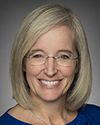I call the meeting officially to order.
Welcome to meeting number 53 of the House of Commons Standing Committee on Finance.
Pursuant to the House order of reference of Thursday, May 27, 2021, the committee is meeting to study Bill C-30, an act to implement certain provisions of the budget tabled in Parliament on April 19, 2021, and other measures.
Today's meeting is taking place in a hybrid format pursuant to the House order of January 25 of this year. Therefore, members are either attending in person in the room, or remotely using the Zoom application.
I sometimes hear those words in my sleep these days. We have repeated them so many times.
I hate to start without Mr. Julian, without one party here, but we will see where we are at first.
(On clauses 269 to 271)
We had started a discussion—and you can correct me if I'm wrong, Mr. Clerk—on division 32, an increase to the old age security pension and payment. It was on page 286 of the bill. I believe the lead for the department was Kristen Underwood. There she is.
Welcome, Ms. Underwood.
The floor is open for further discussion on division 32.
Mrs. Jansen.




